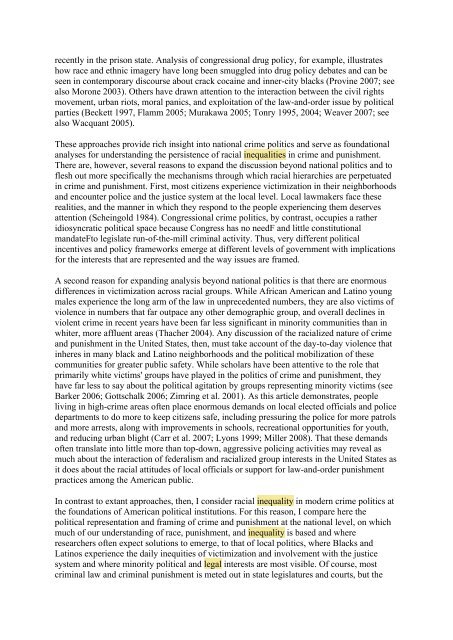The Invisible Black Victim: How American Federalism Perpetuates ...
The Invisible Black Victim: How American Federalism Perpetuates ...
The Invisible Black Victim: How American Federalism Perpetuates ...
You also want an ePaper? Increase the reach of your titles
YUMPU automatically turns print PDFs into web optimized ePapers that Google loves.
ecently in the prison state. Analysis of congressional drug policy, for example, illustrates<br />
how race and ethnic imagery have long been smuggled into drug policy debates and can be<br />
seen in contemporary discourse about crack cocaine and inner-city blacks (Provine 2007; see<br />
also Morone 2003). Others have drawn attention to the interaction between the civil rights<br />
movement, urban riots, moral panics, and exploitation of the law-and-order issue by political<br />
parties (Beckett 1997, Flamm 2005; Murakawa 2005; Tonry 1995, 2004; Weaver 2007; see<br />
also Wacquant 2005).<br />
<strong>The</strong>se approaches provide rich insight into national crime politics and serve as foundational<br />
analyses for understanding the persistence of racial inequalities in crime and punishment.<br />
<strong>The</strong>re are, however, several reasons to expand the discussion beyond national politics and to<br />
flesh out more specifically the mechanisms through which racial hierarchies are perpetuated<br />
in crime and punishment. First, most citizens experience victimization in their neighborhoods<br />
and encounter police and the justice system at the local level. Local lawmakers face these<br />
realities, and the manner in which they respond to the people experiencing them deserves<br />
attention (Scheingold 1984). Congressional crime politics, by contrast, occupies a rather<br />
idiosyncratic political space because Congress has no needF and little constitutional<br />
mandateFto legislate run-of-the-mill criminal activity. Thus, very different political<br />
incentives and policy frameworks emerge at different levels of government with implications<br />
for the interests that are represented and the way issues are framed.<br />
A second reason for expanding analysis beyond national politics is that there are enormous<br />
differences in victimization across racial groups. While African <strong>American</strong> and Latino young<br />
males experience the long arm of the law in unprecedented numbers, they are also victims of<br />
violence in numbers that far outpace any other demographic group, and overall declines in<br />
violent crime in recent years have been far less significant in minority communities than in<br />
whiter, more affluent areas (Thacher 2004). Any discussion of the racialized nature of crime<br />
and punishment in the United States, then, must take account of the day-to-day violence that<br />
inheres in many black and Latino neighborhoods and the political mobilization of these<br />
communities for greater public safety. While scholars have been attentive to the role that<br />
primarily white victims' groups have played in the politics of crime and punishment, they<br />
have far less to say about the political agitation by groups representing minority victims (see<br />
Barker 2006; Gottschalk 2006; Zimring et al. 2001). As this article demonstrates, people<br />
living in high-crime areas often place enormous demands on local elected officials and police<br />
departments to do more to keep citizens safe, including pressuring the police for more patrols<br />
and more arrests, along with improvements in schools, recreational opportunities for youth,<br />
and reducing urban blight (Carr et al. 2007; Lyons 1999; Miller 2008). That these demands<br />
often translate into little more than top-down, aggressive policing activities may reveal as<br />
much about the interaction of federalism and racialized group interests in the United States as<br />
it does about the racial attitudes of local officials or support for law-and-order punishment<br />
practices among the <strong>American</strong> public.<br />
In contrast to extant approaches, then, I consider racial inequality in modern crime politics at<br />
the foundations of <strong>American</strong> political institutions. For this reason, I compare here the<br />
political representation and framing of crime and punishment at the national level, on which<br />
much of our understanding of race, punishment, and inequality is based and where<br />
researchers often expect solutions to emerge, to that of local politics, where <strong>Black</strong>s and<br />
Latinos experience the daily inequities of victimization and involvement with the justice<br />
system and where minority political and legal interests are most visible. Of course, most<br />
criminal law and criminal punishment is meted out in state legislatures and courts, but the














